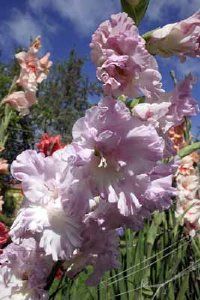The name gladiolus means "little sword" in reference to the sword-shaped leaves of the plant. Every flower color but blue is represented in modern hybrids, and the flowers themselves vary immensely. They are members of the iris family.
Advertisement
Description of gladiolus: The erect spikes of flowers, from 1 to 4 feet tall, grow through the swordlike leaves from the corm, a modified stem planted underground. The individual flowers are classified by size by the North American Gladiolus Council, from miniatures with flowers under 21/2 inches in diameter to giants over 51/2 inches in diameter.
Growing gladiolus: Gladiolus grows best in well-drained soil high in organic matter, in full sun. Shelter from heavy winds. Where the ground does not freeze, corms may be left in the ground from year to year. Elsewhere, plant each spring in succession to assure continuous bloom. Plant the first about the time deciduous trees are sprouting new foliage, continuing about every 2 weeks until the first of July, Bloom occurs 60 to 70 days after planting. Fertilize a month after planting and again just before the first flowers open. Water regularly if dry.
Propagating gladiolus: By corms. The tiny corms that form around each corm can be saved at digging (keep separate and label by variety), then planted in the spring for size increase.
Uses of gladiolus: Glads can be used to provide a succession of color, especially in perennial borders when early blooming perennials have finished. Plant them in clusters or groups. They make superb cut flowers, and if wanted primarily for cutting, can be planted in rows in the cutting garden.
Gladiolus related varieties: There are named varieties by the hundreds.
Scientific name of gladiolus: Gladiolus hybridus
Advertisement
